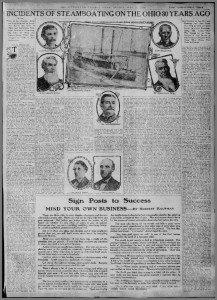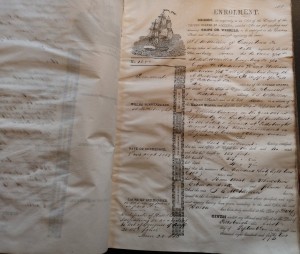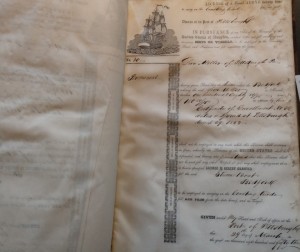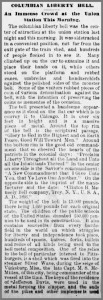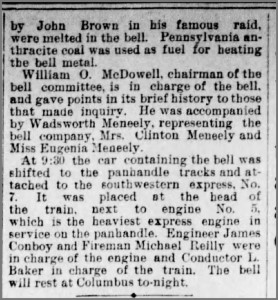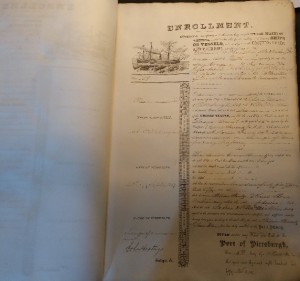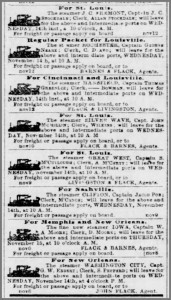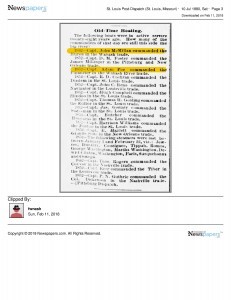Captain John Smith McMillin
Captain John Smith McMillin
History books inform us that the shelling of Ft Sumter in Charleston Bay marked the beginning of the Civil War. This bombardment provoked the war between the states, but the shots fired there on 12 April 1861 were not the first act of war.
Talk of secession had advanced beyond words before the attack on Ft Sumter. In Dec 1860, South Carolina was the first state to secede from the union. Others followed. Rumors of war were rife in local newspapers. A southern sympathizer, Sec of War John B Floyd under Pres Buchanan and a former governor of VA, sent an order to the Allegheny Arsenal in Pittsburgh to ship 124 canons to New Orleans and Galveston. The steamers Silver Wave and Marengo were contracted by the US Army to transport the artillery south. Col John Symington, the commander of the Allegheny Arsenal, attempted to obey the order from Washington under the darkness of Christmas Eve. When citizens of Pittsburgh learned of this action ─ from a whistleblower at the arsenal ─ the citizens protested, knowing that the guns would be used to fortify the south. Angry Pittsburgh crowds halted the movement of the canons and their military escorts to the Monongahela wharf. Before the crowds blocked the streets to the wharf, thirty-eight guns had been loaded on the str Silver Wave. Further, Pittsburgh citizens threatened to blow the str Silver Wave out of the water if it’s captain attempted to go down the Ohio River with the thirty-eight guns aboard. To avoid potential violence the order for shipment was countermanded. The str Silver Wave never left the wharf. [1]
Southern politicians in Congress were outraged that ordinary Pittsburgh citizens threatened to interfere with military orders for the distribution of federal artillery and munitions south of the Mason-Dixson Line. The protest by the citizens of Pittsburgh which prevented the repositioning of 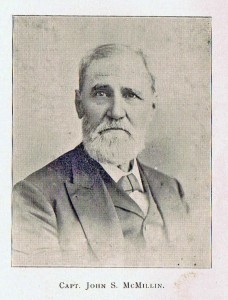 arms was the first genuine act of war between the North and South. Their citizen activism reminds us of the need to resist – to do what is right.
arms was the first genuine act of war between the North and South. Their citizen activism reminds us of the need to resist – to do what is right.
The packet at the center of this turmoil was owned and operated by Capt John Smith McMillin.
Later in 1863, the str Silver Wave was the first noncombat steamboat to successfully pass the Vicksburg batteries. That feat was a big deal! Vicksburg, deemed impassable, was the last Confederate stronghold on the Mississippi River. The Union convoy, three gunboats and the str Silver Wave and three other packets, was riddled with holes carrying supplies to Gen Grant’s army below the city. Many historians consider the fall of Vicksburg the tipping point of the Civil War. In that campaign, Capt John Smith McMillin played a consequential role.
Capt John Smith McMillin, born on 23 Jul 1817 in Georgetown, PA, began his river career keel-boating in the 1830’s. In the 1850’s he was the primary owner and master of several packets. He moved to Grandview Ave on Mt Washington in Pittsburgh in 1853. My 3rd great grand uncle, Capt John Smith McMillin, will first and always be a Georgetown man of honor.
Family Background.
A news article about general history of the steamboat era taken from The Pittsburgh Gazette Times dated 5May1909 is a tribute to the men who steamed on the Ohio River. Two of the seven portraits are Georgetown captains: Jacob and Adam Poe. Two partial columns of print are devoted to Georgetown and the men who worked the river from there. Capt Thomas S Calhoon is described in detail. Others such as George W Ebert, Standish Pepard, Thomas Poe, Richard Calhoon, George Laughlin are documented in a sentence. Capt John S McMillin was included with Georgetown men even though he had moved to Grandview Ave in Pittsburgh in 1853.
Business Ventures.
Str Huron. The str Huronwas a sternwheel wooden hull packet built in 1851 at
Christler’s Landing, PA (now called Shippingport). It was rated at 168 tons. Its dimensions were 157x24x4’8’. According to Way’s Directory the str Huron was snagged and lost on 23 Feb 1855 on the Atchafalaya River. [1]
The Certificates of Enrollment Record Type 41 provided evidence that Capt John S McMillin was the primary owner and master of the str Huron in 1852 and 1853. In the registration for 1853, there was a change in ownership. One partner from 1852 was removed (T Keffer) and the share of ownership for JS McMillin increased equal to the share of the partner removed. In other words, he bought out one partner.
No documents nor newspaper clips have been discovered to indicate where Capt JS McMillin was nor what he was doing in 1852/53. If he was following the path of his Georgetown neighbors, he was probably working on the lower Missouri River transporting passengers and their belongings to their jump point for the long trek to the west along te Mormon or Oregon Trails.
Str Huron Certificate of Enrollment translated
| Owners and Partners | Share | Vol: | 6634 ? |
| JS McMillin | 9/16 | Enroll No : | 128 |
| Steel McMillin | 1/24 | Cert Date: | 1 Sep 1852 |
| Geo Anderson | 1/8 | Cert Type:: | Enrollment |
| Wm Anderson | 1/16 | Build Locn: | Christler’s Landing, PA |
| A Wilkins | 1/8 | Build Date: | 1851 |
| T Keffer | 1/12 | Master | John S McMillin |
Str Bedford
The str Bedford was a stern wheel packet rated at 180 tons. Its dimensions were 155’x24’8”x5’. Like the str Huron, the str Bedford was built at Christler’s Landing, PA. According to Way’s Directory, the str Bedford met its end by fire at Harpeth Shoals, TN on 1 Jun 1854. The probable location of the wreck was on the Cumberland River approximately 40miles below Nashville..
No documents or newspaper clips have been found to determine the work of the str Bedford. Unlike Poe family vessels where profits and risks were shared, it appears that Capt JS McMillin consolidated his ownership of this steamer.
Str Bedford Certificate of Enrollment translated
| Owners and Partners | Share | Vol: | 6634 ? |
| JS McMillin | 14/16 | Enroll No : | 157 |
| A Bailly | 1/16 | Cert Date: | 1 Sep 1852 |
| A Wilkins | 1/16 | Cert Type:: | Enrollment |
| Build Locn: | Christler’s Landing, PA | ||
| Build Date: | 1851 | ||
| Master | John S McMillin |
Str Silver Wave
The str Silver Wave has a markedly, extraordinary history of service during the Civil War. On 24 Dec 1860, the str Silver Wave was contracted by the US Army to transport canons from the Allegheny Arsenal in Pittsburgh to New Orleans. That contract caused a riotous protest in Pittsburgh. On 18 Oct 1861, the Silver Wave was one of six packets contracted to transport the first Pittsburgh enlisted troops to Louisville, Ky. The str Clara Poe was also one of the select six. [2] On 9 May in 1862, str Silver Wave docked in Pittsburgh with a cache of arms captured from the Confederacy after the fall of Island No 10. In 1863, the Silver Wave was the first noncombat steamer to successfully pass the Vicksburg batteries. That was a very big deal. In 1864, str Silver Wave was with Gen Porter on the Red River.
The str Silver Wave was severely damaged during its runs through the Vicksburg batteries. The str Horizon owned by Captains John N McNurdy and Thomas S Calhoon og Georgetown, collided with the str Moderator on its second pass by the batteries. The str Horizon was a complete loss with many lives lost. Neither vessel received full compensation for their losses.
Several letters were exchanged requesting compensation. The claims went through the US Army Quartermaster. In 1873, the claim was rejected and partially satisfied.
An astounding resume for any steamboat captain. A final honor for str Silver Wave was its connection to the Columbian Liberty Bell manufactured by Clinton H Meneely Bell Co, Troy, NY in 1893 for the Columbian Exposition. A shell fired into the str Silver Wave was one of the relics used to forge the bell. Other relics included the keys of the residence of Jefferson Davis, 250K pennies donated by public school students and souvenirs from the battlefields where American struggles for freedom took place.
Built for Capt JS McMillin in Glasgow, PA (opposite Georgetown) in 1854, the str Silver Wave was a sternwheel wooden hull packet rated at 245 tons. [3] Before the Civil War, the str Silver Wave was a tramp steamer in the Pittsburgh to Cincinnati to Louisville trade, and also made appearances on the upper Mississippi River.
Str Silver Wave Certificate of Enrollment translated
| Owners and Partners | Share | Vol: | 6637 |
| JS McMillin | 13/16 | Enroll No : | 189 |
| Charles Wilkins | 1/16+1/32 | Cert Date: | 5 Dec 1856 |
| Steel McMillin | 1/16+1/32 | Cert Type:: | Enrollment |
| Build Locn: | Glasgow PA | ||
| Build Date: | 1854 | ||
| Master | John S McMillin |
In a newspaper advertisement in the Pittsburgh Daily post the str was scheduled for departure at 10:00 AM on Wed, 14 Nov 1855. The clerk identified in the ad was Wilkins, probably a partner. In the same column of newsprint ”News for Rivermen” the weather was clear and pleasant. The river level was 5’11” and falling.
Georgetown Packets on Wed, 14Nov1855.
| Steamer | Master | Clerks | Destination |
| Washington City | Capt George W Ebert | S Peppard | New Orleans |
| Clifton | Capt Jacob Poe | M’Cance | Nashville |
| JC Fremont | Capt Jackman T Stockdale | A Stockdale | St Louis |
| Silver Wave | Capt John S McMillin | Wilkins | St Louis |
Four of eight boats departing Pittsburgh were owned and commanded by Georgetown men. That day other Georgetown captains, such as Jacob Poe’s brothers (Adam and Thomas), Jackman Stockdale’s nephew (Thomas S Calhoon), and the Calhoon brothers (John and Richard) were no doubt plying the watery highways to faraway ports with the hope of being home from the Christmas holiday.
Capt John Smith McMillin was also an inventor. In that role, he was awarded a US Patent for the invention of the steam-powered capstan. [4] The capstan patent was a Letters Patent No 63,917, granted on 16 Apr 1867 to John S McMillin for “an improvement in applying steam-power to the capstans of steamboats and other craft”. [5]
The steam-powered capstan patent was contested in court in two cases, if not more. One case in 1875 was decided in his favor. See McMillinJohn 750927 PatentRyuling PittWeeklyazette p4.
Another suit, McMillan [6] v Rees [7] (17 OG, 1222), was filed against John S McMillin to “restrain the infringement” of the patent. The circuit court opinions issued in both cases were not in favor of Capt McMillin. The capstan patent was declared void “for want of any patentable invention”. The basic arrangement of “shafts and cog-wheels” of the capstan was unchanged. In the case against McMillin, the argument was that the modification to steam power did not warrant the issue of a patent because there was no “ingenuity of merit”, only the “ordinary judgement and skill of a trained mechanic”. Capstans and steam engines were old technology, well known elements used in many places including grist mills and steamboats.
Capt McMillin appealed the decisions. On 17 Nov 1884, the Supreme Court of the US decided:
Upon the ground stated, we think the letters patent upon which the suit is based are void. The decree of the circuit court by which the patent was sustained must therefore be reversed and the cause remanded with direction to dismiss the bill, and it is so ordered. [8]
The history of the patent process was long and curious. The first application for the patent was filed by Capt McMillin on 23 Jul 1855. This application was rejected. On 7 Feb 1856, the application was amended. This amended application was also rejected. Eleven years later, the application awarded the patent included the drawings and specifications of the first application unchanged. The steam-powered capstan had been in wide use for more than a decade without any new state of the art developments or improvements. That was the defense relied on to defeat the patent in court.
It is unclear whether John S McMillin was demanding royalties from other steamboat owners and lines.
An article from the St Louis Dispatch dated 10 Jul 1880 looks back 28 years to identify the prominent steamboat captains of 1852. Plus one-hundred-forty years from the news article. Of the thirteen captains named in 1852, Capts John S McMillin and Adam Poe were residents of Georgetown, PA. Both Georgetown captains were working on the Wabash River.
Burials.
July 10. 1866:
PHEBE ANN McMILLIN, aged 50 years, wife of Capt. John S. McMillin, of Grandview avenue and Bigham street. Service at the church, conducted by Dr. Killikelly, the rector, assisted by the Rev. Dr. Page and the Rev. Mr. Snively, of the city. Buried in Allegheny Cemetery. “A devout communicant of Grace Church, a most excellent Christian woman and a valuable member of the church and of society.”
March 14, 1893:
JOHN SMITH McMILLIN, aged 76 years. Service at the late residence of the deceased, Grandview avenue and Bigham street, and interment in Allegheny Cemetery, the Rev. R. J. Coster, his pastor and friend for twenty-five years, officiating. A strong character, noted for his simplicity and integrity. (See Note 5.)
A biography of Capt John S McMillin was included in the history of A history of the Grace Church Parish transcribed or contributed by Joan Skinnell Benincasa. See footnote [9]
The Columbian Exhibition in 1893 was a fitting and glamorous way to enter into the coming Twentieth Century. The exhibition also marked the time of John Smith McMillin.
References and Notes.
[1] Frederick Way,Jr, Way’s Packet Directory, 1848-1994, p219.
[2] Arthur B Fox, Pittsburgh during the Civil War, 1860-1865, p. 31-32. “Thousands of men, women and children lined the river bank to give the men a sendoff…The 78th PA Infantry was boarded on Captain Thomas Poe’s steamboat Clara Poe and the Moderator while the remainder of the men. horses and canon boarded on the four other steam boats.” ”At 6:00 PM ropes were released, whistles sounded, anchors weighed, and the Clara Poe… sailed quickly from the Monongahela River into the Ohio River enroute to their jump-off point of Louisville, Kentucky, some three days away. Some of the soldiers standing at the ship’s railing, watching the city quickly disappearing into the darkening sky, would never live to see Pittsburgh again” [
[3] Frederick Way,Jr, Way’s Packet Directory, 1848-1994, p427-428.
[4] A capstan was a spool device mounted on the steamboat deck used for winding up heavy rope. With booms and block-and-tackle, a capstan was used to move heavy loads on and off the boat. It was also used when “sparring” the boat over sandbars. Before the steam-power improvement, the cylinder was turned by muscle power.
[5] Decisions of the Commissioner of Patents and of the US Courts in Patent Cases for the Year 1884, Washington Government Printing Office, 1884, p472.
[6] McMillin was misspelled, or at least spelled differently. In the two lower court challenges, the name is spelled with an “in” on one docket and “”an” on the other. Adding to the confusion, the name McMillen is found on markers in Georgetown Cemetery. Changing the spelling of a family name was not uncommon at that time in our history. Such changes occurred between generations rather than within a family. That makes this case unusual.
[7] Rees is a famous steamboat family from Pittsburgh. Thomas M, James H, or William, or the Rees firm could have filed the complaint.
[8] Decisions of the Commissioner of Patents and of the US Courts in Patent Cases for the Year 1884, Washington Government Printing Office, 1884, p475.
[9] A history of the Grace Church Parish
CAPT. JOHN SMITH MCMILLIN.
John Smith McMillin, son of William and Catherine Smith McMillin, Scotch-Irish Covenanters, who settled in Beaver County at the close of the last century, was born July 23, 1817, in Georgetown, Beaver County, Pa., where he spent his youth and received a common school education. He was the fourth child of a family of thirteen children. When fifteen years old he engaged in keel-boating on the Ohio River; he next became a pilot on a steamboat, and soon, by quickness and attention to business, he became a captain and was master and owner of several fine boats, and ran regularly to Memphis, New Orleans and all points on the Lower Mississippi River. During the Civil War he won for himself high reputation for bravery by fearlessly running the blockade at Vicksburg in his boat, the Silver Wave, and carrying supplies to the army below the city.
He invented and put into successful use the well-known steam capstan, now a necessary part of the equipment of every river steamboat.
In April, 1853, he moved to Pittsburgh and built a home on Grandview avenue, corner of Bigham street, Mount Washington, where he continued to reside until his death.
He was married twice. His first wife was Phebe Ann Fry, daughter of Dr. Thomas Fry, of Rhode Island, who moved with his family to Georgetown. They were married in Georgetown in December, 1846, and Mrs. McMillin died in Pittsburgh July 8, 1866, leaving no children. His second wife, Mary Bindley, eldest daughter of John C. and Elmina Bindley, of Pittsburgh, he married August 7, 1867. She and three children, one daughter and two sons, survive him. He was baptized by Dr. Killikelly, in Grace Church, July 10, 1866, at the funeral of his first wife, beside the remains, and was confirmed by Bishop Kerfoot in St. Peter’s Church, Pittsburgh, April 14, 1867. He was a vestryman of Grace Church nearly thirty years ; was several times senior warden ; six years treasurer of the church, and was frequently deputy of the same church to the Annual Convention of the Diocese of Pittsburgh. He was a liberal contributor to the expense of putting a basement schoolroom under the church in 1865, and also to the fund for finishing and furnishing the church in 1869. He was a contributor to the support of the church from the time he moved to Mount Washington and a communicant of the same for twenty-six years. He died March 11, 1893, in the seventy-sixth year of his age.
The circumstances of his death were peculiar. On Saturday morning, March 11, 1893, he started as usual for his place of business in the city, the Bindley Hardware Company. Near his gate he met Miss Elizabeth Kenah, and they walked on together, the Captain being, as he often was, in a joking, playful mood. They were proceeding along Grandview avenue going toward the Monongahela Incline Plane, and had just crossed Stanwix street, when he threw his left hand up to his head with an exclamation of sudden pain, tottered, and laid hold of the fence at the side of the street, sank down to the ground and in a few moments (before a physician could reach him) was dead.
The funeral service was held at his late residence on Tuesday, March 14, 1893, at 2 P. M., in the presence of a large gathering of his relations and friends, and he was buried the same afternoon in Allegheny Cemetery.
He was a well-known man, of strong character, noted for his simplicity, honesty and sincerity.
The Rev. R. J. Coster, in an address at his funeral, said:
“God’s providences sometimes touch our hearts with peculiar force and stir our feelings to their lowest depths. Their suddenness and their pathetic surroundings point to God’s immediate presence and tell us that they are the work of His Hand. We cannot read the secret counsels of the Almighty; but this we know, His ways are wise and merciful. He doeth all things well. His infinite wisdom precludes mistakes. In faith, therefore, we bow to His Blessed Will, believing that His ordering is best. In times of sudden bereavement, like this, the promises of God’s Holy Word come to give us resignation and comfort. The Church of Christ, the mother of all the believing, comes to us with her sacred ministrations; her lessons and her prayers speak to us in Christ’s name and bid us fear not, faint not.
“These thoughts harmonize well with the occasion that brings us together here today. Our friend and fellow-servant of God, to whom His Master granted more than his three-score years and ten, has been suddenly taken from our midst. So unexpected was the summons that we can hardly yet realize that we shall no more meet him in his home; no more meet him in the church. We have been so long accustomed to see his tall form and his striking features, so long accustomed to see his kindly smile and to hear cordial welcome, that we shall sadly miss him many days. We had learned to look upon him almost as a permanent part of this community. For forty years he had occupied this home and identified himself with the interests of this section of the city. Most or all of those years he has been closely connected with Grace Church. For nearly thirty years he was one of its vestrymen; he was several times senior warden, for many years treasurer, and frequently he represented his parish in the Diocesan Convention All these years he and his family have been members of Grace Church, and often have they come to its aid in times of need. Some of you have known our departed friend longer than I have, but for nearly twenty-five years I have enjoyed his friendship and confidence.
His home was always open to me, and here I always met a kindly greeting and a cordial welcome. I constantly met him on terms of closest intimacy, and this intimacy only increased my confidence and respect for the man. As one learned to know him well, and to understand his ways and modes of expression, one could not fail to appreciate the sterling traits of his character, his simplicity, his honesty, his sincerity. Like every man of strong character, he had his peculiarities, and these peculiarities caused him sometimes to be misunderstood by those who imperfectly knew him. But to his intimate friends these peculiarities only intensified his personality and made him the man that they love to honor and remember. His sudden departure while still busy with his ordinary duties, the tragic termination of his active life, will tend to prolong his memory and to deepen the keenness of our sense of loss. But let us not sorrow for him as men without hope. He was a believer in Christ. He was a communicant of the Church. He died in the faith; and although he was reserved in the expression of his religious convictions, as most men of a like character are, yet he accepted the great truths of the Gospel and died trusting in his Lord. We can, therefore, lay him to rest believing that God will deal mercifully with him for Christ’s sake and give him the rest and peace that shall be the portion of his faithful people.”
Copyright©2019 Francis W Nash All Rights Reserved
No part of this website may be reproduced without permission in writing from the author.
